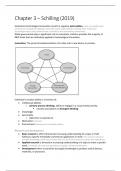Samenvatting
Strategic Management of Technology and Innovation (SMTI) Summary – (Grade: 8)
- Instelling
- Vrije Universiteit Amsterdam (VU)
This is an in-depth summary for the primary book used in the Strategic Management of Technology and Innovation course at VU. Only using this summary, I got an 8 in the final exam (max grade attained in this class was an 8.2). Why am I selling a summary for the book instead of the slides? Because m...
[Meer zien]




